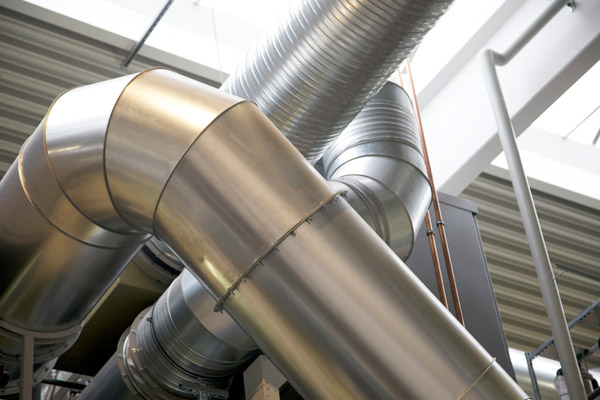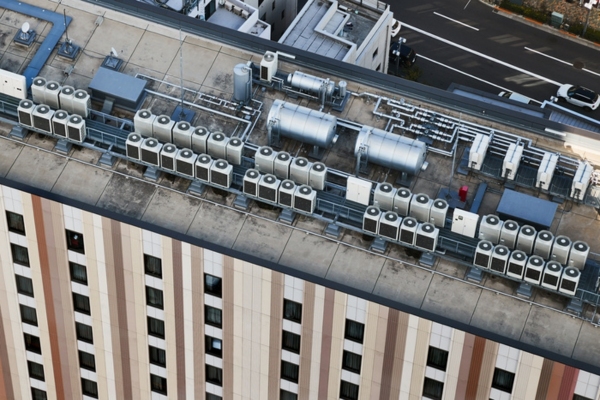
The advent of air conditioning technology has profoundly impacted the field of architecture and building construction. It facilitates the adaptation of structures to various environmental conditions while improving the comfort levels of occupants. This article from Point Bay Fuel delves into the effects of cooling technology on architectural practices, focusing on its influence on building designs, materials, and spatial layouts.
Exploring the connection between advancements in air conditioning and architectural innovations provides valuable perspectives on the evolution of contemporary, sustainable, and comfortable living spaces.
Cooling Confluence: How Cooling Technology Shapes Architectural Design
The intertwined development of cooling technology and architectural design has fundamentally transformed our built environments.
Advancements in Air Conditioning Technology

The progression of air conditioning technology from primitive techniques to modern, sophisticated HVAC systems represents a significant journey of innovation and adaptation. Initial advancements, like the creation of mechanical cooling, catalyzed a transformative era in architecture, allowing structures to transcend environmental constraints and elevate the comfort of their occupants.
Significant advancements, such as introducing energy-efficient and eco-friendly refrigerants, have also shaped architectural design. This helps promote a more sustainable and inventive approach to construction practices. This evolution underscores the pivotal role of air conditioning in driving architectural innovation and influencing how we design, build, and interact with spaces.
Ensure your indoor comfort seamlessly with Point Bay Fuel’s reliable air conditioning services. Contact us for customized support today.
The Air Conditioner’s Influence on Building Design

The introduction of air conditioning technology has significantly impacted architectural design and building layouts. This prompts a move towards enclosed, climate-controlled environments focused on comfort and functionality. This integration of technology has initiated shifts in building aesthetics, orientation, window design, and spatial organization, enhancing design flexibility and energy efficiency.
Architects now deliberately plan building orientation and window placement to maximize natural light. They also design them to reduce heat gain while accommodating air conditioning systems’ spatial requirements. This development highlights the extensive impact of cooling technology on creating modern, sustainable built environments.
A Cooling System’s Impact on Building Materials & Construction

The advancement of air conditioning technology has transformed our approach to architectural design. They also greatly influenced the choice of construction techniques and building materials. The demand for efficient cooling has favored materials that improve insulation and minimize thermal bridging. Innovative insulating materials, such as high-performance foam and aerogel insulation, have grown increasingly popular. These materials are crucial for maintaining optimal indoor temperatures while reducing energy usage.
Furthermore, embracing green building standards and certifications promotes using materials and construction methods that lessen environmental impact. This approach involves employing sustainably sourced materials, adopting construction methods that minimize waste, and incorporating renewable energy sources.
Choice of Building Materials & Design Principles

The careful selection of building materials and adherence to design principles are essential in improving building performance and occupant comfort:
- Thermal Mass Consideration: Modern buildings incorporate materials with high thermal mass, like stone and concrete, to regulate indoor temperatures. These materials capture heat throughout the day and discharge it at night, naturally cooling the building and decreasing reliance on air conditioning systems.
- Insulation Importance: Insulation is a fundamental component in constructing energy-efficient buildings. High-quality insulation lowers cooling demands and dramatically improves indoor comfort by keeping temperature levels stable and minimizing noise.
- Energy-Efficient Design: The design and orientation of buildings are now carefully optimized to enhance natural ventilation and daylight, reducing the dependence on artificial cooling and lighting. This involves strategic window placement, using reflective materials to decrease heat absorption, and implementing shading devices to manage solar gain.
Trust Point Bay Fuel to manage your cooling needs. Contact us for prompt and professional service.
Integration of Cooling Systems into Architectural Design

In contemporary building practices, seamlessly integrating cooling systems into architectural design is essential, as it balances optimal functionality with aesthetic integrity and spatial utility.
- Design Elements: HVAC ductwork, vents, and grilles have transcended their functional roles and are now considered vital architectural design elements. This integration demands meticulous planning to ensure these systems enhance the overall design narrative of the space, merging effortlessly with both the interior and exterior aesthetics.
- Air Conditioning System Placement: Strategic design and positioning of HVAC systems are vital to achieving efficient air distribution and accurate temperature control. This requires considering the building’s orientation, room layouts, and how spaces are used to identify optimal locations for vents and ductwork. Proper placement boosts the effectiveness of air conditioning systems and improves comfort by guaranteeing even temperature distribution and consistent air quality across the building.
The considerate integration of cooling systems within architectural design reflects a comprehensive approach to building development, where functionality, efficiency, and aesthetic appeal are seamlessly integrated.
Sustainability and Energy Efficiency

The emphasis on sustainability and energy efficiency in architectural design and cooling technologies signifies a pivotal move towards environmentally responsible building practices. Contemporary advancements in air conditioning, including energy-efficient systems and intelligent controls, play a fundamental role in this shift. These systems are designed to maximize comfort while minimizing energy consumption and emissions.
Incorporating renewable energy sources into cooling systems underscores a deep commitment to reducing environmental impact, marking an essential stride toward sustainable development. Air conditioning is vital in mitigating the urban heat island effect and reducing carbon footprints via green building initiatives. Strategies such as installing green roofs, enhancing natural ventilation, and boosting insulation significantly reduce dependence on mechanical cooling, which supports energy conservation and environmental protection.
This trend of embedding sustainability in cooling technology and architectural design elevates energy performance and establishes a new benchmark for crafting environmentally responsible and comfortable living environments.
Stay cool and comfortable effortlessly. Call Point Bay Fuel for prompt and efficient air conditioning repairs and installations.
Future Trends & Innovations in Architecture & Cooling

Upcoming trends in cooling technology, such as passive cooling systems and intelligent HVAC controls, are poised to substantially influence architectural design and urban planning. Passive cooling leverages natural processes to lower temperatures, promoting designs in sync with the environment and decreasing dependency on energy-intensive systems. Intelligent controls offer improved efficiency and comfort by making real-time adjustments based on environmental conditions.
Collaboration among engineers, architects, and HVAC specialists is essential for incorporating these new technologies and ensuring that buildings are aesthetically appealing and functionally advanced. Additionally, green building certifications drive the industry towards improved energy efficiency and sustainability, pointing to a future where architecture and cooling technology progress together to reduce environmental footprints and enhance urban spaces for upcoming generations.
Conclusion
Cooling technology has profoundly impacted architectural design and construction practices, driving innovations that result in more comfortable and sustainable environments. The deep interconnection between air conditioning and architecture underscores the necessity of integrating energy-efficient cooling solutions into modern designs.
As the industry advances, Point Bay Fuel provides expert HVAC solutions designed to meet the complex demands of contemporary architecture. These solutions ensure that projects embrace environmental sustainability and achieve supreme comfort.
Contact Point Bay Fuel for Comprehensive HVAC Services
Point Bay Fuel offers premier heating and cooling solutions throughout Ocean County and Monmouth County, New Jersey. Our team of professionally certified and highly skilled technicians is committed to excellence in HVAC maintenance, repair, installation, and replacement. Our experts have the knowledge and experience to efficiently and effectively service your HVAC system.
We take pride in providing the area’s most cost-friendly heating and cooling services. Choosing our maintenance services can enhance your comfort. This can also increase your system’s energy efficiency and significantly reduce your heating and cooling costs. When HVAC repairs or system replacements are necessary, Point Bay Fuel recommends options that best fit your home and budget.
We back the quality of our work with a robust satisfaction guarantee. Please get in touch with Point Bay Fuel at your earliest convenience for a service appointment. We offer complimentary, no-obligation in-home evaluations.
Contact us now by calling (732) 349-5059 to speak to one of our home comfort specialists! Click the link to view our service area.

Related Articles:
- What Should You Do If Your Air Conditioner Airflow Is Weak?
- Air Conditioning: More Than Cooling – Unveiling Unexpected Health Benefits
- Air Conditioner Care Guide: Steer Clear Of These 3 Bad Habits
- Unveiling the Truth: Rust on Your Air Conditioner Condenser
- Attic Air Conditioners: Essential Features to Keep in Mind
The post The Architectural Shift: How Cooling Technology Redefines Building Design appeared first on Point Bay Fuel.
No comments:
Post a Comment